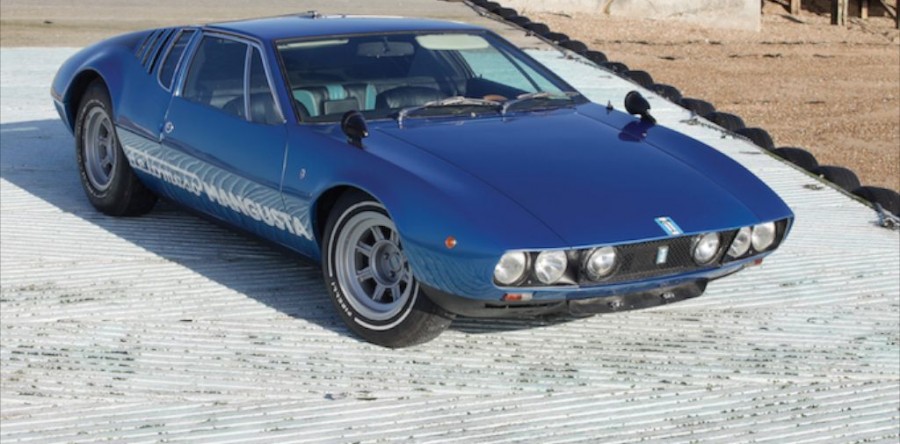Editor’s Note: Our thanks go out to RM Auctions for allowing Monterey Car Week to publish these words and photos on one of the first supercars, a 1969 deTomaso Mangusta Mongoose. RM Auctions will be selling this baby at their upcoming Paris February 4, 2015 event.
Photo Credit: James Mann ©2015 Courtesy of RM Auctions
271 bhp, 289 cu. in. OHV Ford V-8 engine, five-speed ZF manual transmission, unequal length tubular wishbone front suspension with coil springs and an anti-roll bar, wide-base unequal length wishbone rear suspension with trailing arms, coil springs, and an anti-roll bar, and four-wheel power-assisted Girling disc brakes. Wheelbase: 2,500 mm
• A legendary 1960s mid-engined supercar
• Original paint, upholstery, and drivetrain
• Formerly of Peter Kaus’s Rosso Bianco Museum
In the midst of anti-Peron upheavals in the mid-1950s, racing driver Alejandro de Tomaso made his way to Italy, where he drove OSCA race cars for the Maserati brothers. Like several other racing drivers of his day, de Tomaso eventually developed his own automobile, which combined a racing-style chassis, Italian design, and reliable American power, in this case, by Ford.
The first true production De Tomaso was the Mangusta, which was introduced in 1967. It was designed by Giorgetto Giugiaro, built by fabled Turin coachbuilder Ghia, of which de Tomaso had become president, and was reportedly based on the Ford GT40 concept, as it featured a mid-ship V-8 engine, rear transaxle, and backbone chassis. Giugiaro’s muscular, wide-shouldered bodywork emphasised that the engine, which was visible under two clamshell-style rear windows, could propel the car from 0 to 60 mph in 6.3 seconds, through the quarter-mile in 15 seconds at 94 mph, and to a claimed top speed of 155 mph.
The car offered here has a history known back to its time in the renowned Rosso Bianco Museum of Peter Kaus in Aschaffenberg, Germany. It spent about 20 years on display in that legendary sports car collection, during which time it was driven only a few kilometres but was very well preserved. At the museum’s dispersal in 2006, it was sold to its present European owner, in whose collection it has been well-maintained since.
The Mangusta still wears what is believed to be its original bright blue paintwork and interior. Both show the expected wear of a 40-year-old collector car, but they have the charm and patina that only age can provide. This is certainly one of a few De Tomasos of any type that still retain their original finishes. According to the owner, it is in good running order and is believed to be the only Mangusta fitted with six headlights by the factory.
This car, which features an Italian design with an American heart, would be a fascinating addition to any collection of pioneering supercars.
deTomaso Mangusta
En Francais — In French
Moteur V-8 Ford, 289 ci (4 735 cm3), 271 ch, soupapes en tête, boîte ZF manuelle cinq rapports, suspension avant indépendante par triangles inégaux, ressorts hélicoïdaux et barre antiroulis, suspension arrière par triangles inégaux, bras tirés, ressorts hélicoïdaux et barre antiroulis, freins assistés Girling à disque sur les quatre roues. Empattement: 2 500 mm
• Légendaire supercar à moteur central des années 1960
• Peinture, sellerie et moteur d’origine
• Ancienne propriété du Rosso Bianco Museum de Peter Kaus
Au cours de la tourmente anti-Perón du milieu des années 1950, le pilote automobile Alessandro de Tomaso s’est rendu en Italie, où il a couru au volant d’une Osca pour les frères Maserati. Comme de nombreux autres pilotes italiens, De Tomaso a fini par se lancer dans la construction de sa propre automobile, qui combinait un châssis inspiré de la course, un dessin italien et un moteur américain fiable, en l’occurrence un V8 Ford.
La première vraie De Tomaso de série était la Mangusta, dévoilée en 1967. Dessinée par Giorgetto Giugiaro, fabriquée par le fameux carrossier turinois Ghia, dont De Tomaso était devenu président, elle aurait été dérivée du concept Ford GT 40, avec un moteur V-8 central, une boîte transaxle et un châssis-poutre. Le dessin musclé et large d’épaules de Giugiaro soulignait les performances permises par le moteur, lui-même visible sous deux panneaux transparents s’ouvrant chacun latéralement, en fenêtre. La Mangusta passait de 0 à 100 km/h en 6,3 secondes, couvrait le 400 m départ arrêté en 15 secondes et atteignait 250 km/h en pointe.
La voiture que nous proposons présente une histoire connue depuis la période où elle était exposée au sein du fameux Rosso Bianco Museum de Peter Kaus, à Aschaffenberg en Allemagne. Elle est restée une vingtaine d’années en exposition dans la fameuse collection de voitures de sport et de course, période au cours de laquelle elle n’a parcouru que quelques kilomètres, tout en bénéficiant de bonnes conditions de préservation. Lors de la dispersion des pièces du musée, en 2006, elle a été vendue à l’actuel propriétaire européen, qui l’a conservée depuis au sein de sa propre collection.
Cette Mangusta comporte encore ce que l’on pense être sa peinture bleu clair et sa sellerie d’origine. L’une et l’autre montrent la fatigue correspondant à 40 ans de collection, mais ont le charme de la patine que seul l’âge peut apporter ; Il s’agit certainement d’une des rares De Tomaso, tous modèles confondus, qui présente encore sa finition d’origine. D’après le propriétaire, elle est en bon état de fonctionnement et semble être la seule Mangusta équipée d’origine de six phares.
Avec son dessin italien et son moteur américain, cette voiture représentera un apport précieux à toute collection constituée autour des premières supercars.

























